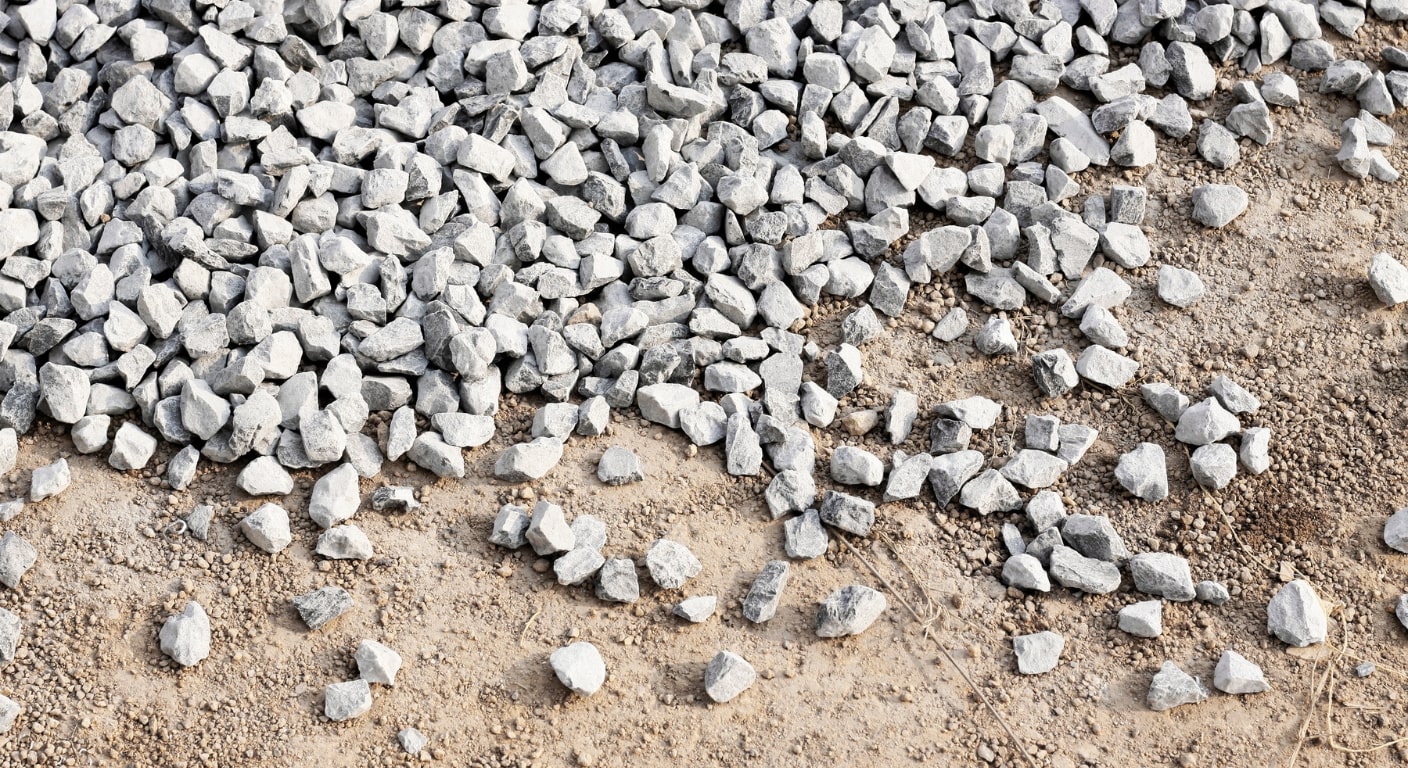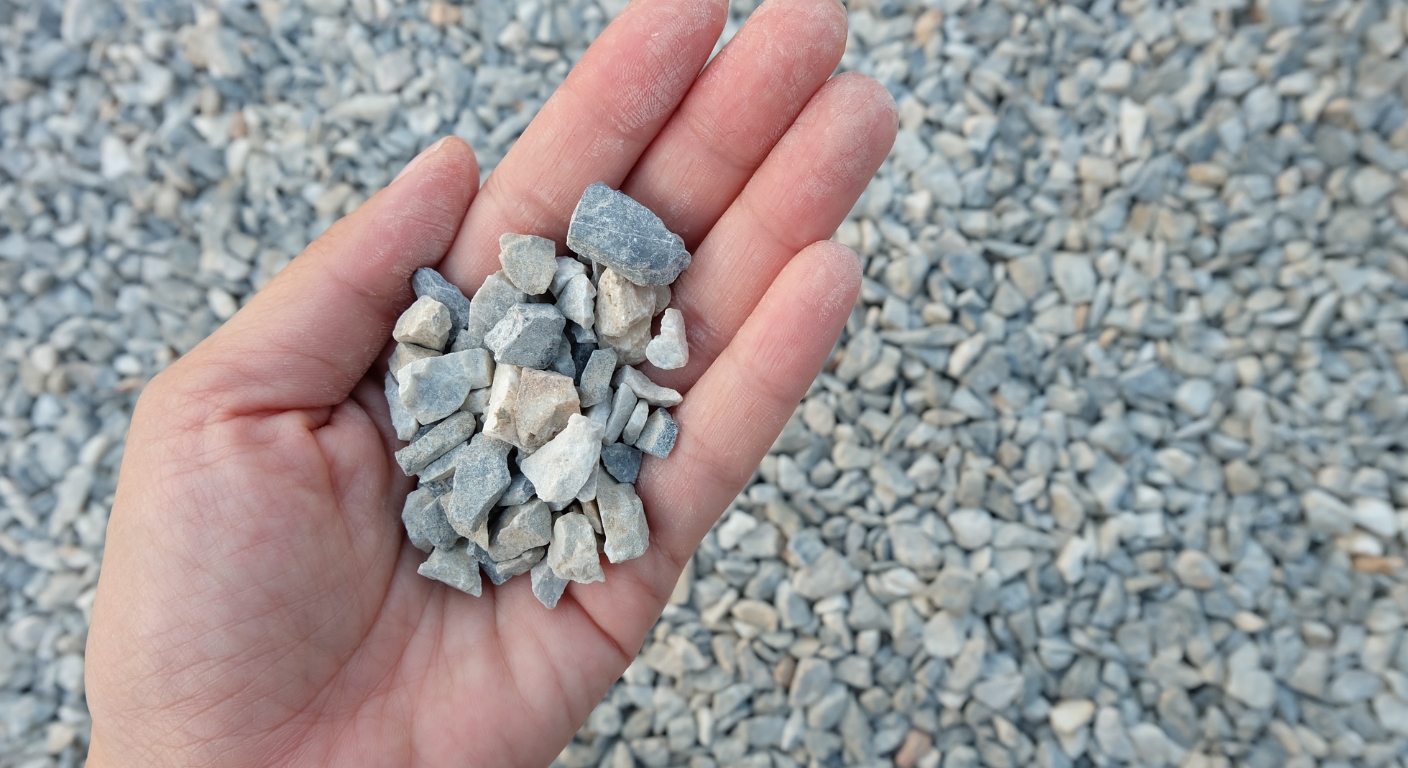When planning a construction or landscaping project, the choice of base material is one of the most important decisions you’ll make. The right aggregate affects everything from stability and drainage to appearance and long-term durability. Yet terms like crushed rock, gravel, and stone are often used interchangeably, which can lead to costly mistakes.
This guide breaks down the distinctions between these three aggregate types, offering contractors, landscape architects, property managers and others a clear framework for choosing the right rock. Our aim is to provide you with a practical understanding of crushed rock vs gravel vs stone, and how each can best serve your project.
A Brief Overview of Aggregate Types
In construction and landscaping, “aggregate” refers to granular materials, which can be either natural or processed materials, which form the foundation or finishing layer of many projects.
Aggregates, including crushed stone, gravel, sand, and similar materials, have been used by civilized cultures for thousands of years, essentially since the first large-scale construction projects. For example, as early as 2600 BCE, the ancient Egyptians used naturally occurring gravel, sand, and crushed stone as part of the mortar and foundation materials for pyramids and temples.
2,400 years later the Romans perfected aggregate use in concrete, essentially lime mixed with volcanic ash and added to stone aggregate, which allowed them to build massive aqueducts, amphitheaters, and the Colosseum. In addition, many Roman roads were paved with layers of compacted crushed rock and gravel, some of which are still in use today.
After the Romans in Europe of the Middle Ages stone and gravel aggregates were widely used in castle construction, cathedrals, and fortifications, often combined with lime mortar. And, while the details differ, the principles of using crushed rock, gravel, and stone remain the same.
Not All Aggregate is the Same
Typically, aggregates include sand, gravel, crushed rock, and quarried stone. Additionally, for most professional projects, the three primary aggregate types are:
- Crushed Rock: Mechanically broken pieces of larger rock.
- Gravel: Naturally rounded rock fragments from riverbeds or glacial deposits.
- Stone: Larger quarried pieces, often used for structural or decorative purposes.
For contractors and others engaged in building projects, understanding these differences is essential for making accurate base rock comparisons, choosing the right rock, and preventing performance issues down the road. Because the “hard fact” is that – as experts know – there are real distinctions between crushed rock vs gravel vs stone.
So, let’s take deeper dive into these aggregate types.

Crushed Rock: Characteristics & Uses
Crushed rock is produced by mechanically breaking down larger quarried rock into angular fragments. This starts by mining natural rock deposits. Then, large machines called crushers break the mined rock into smaller, angular pieces. This crushed rock is sent through a screener that sorts it by size, ensuring each batch is perfect for specific uses like building foundations, roads, or for landscaping projects.
Key Characteristics of Crushed Rock:
- Angular edges that interlock for strength.
- Available in a wide range of rock sizes for construction (commonly 3/8″ to 3″).
- Dense and compactable, making it ideal for load-bearing applications.
Common Uses:
- Road base and subgrade stabilization.
- Foundation backfill and driveways.
- For drainage systems when washed and sized appropriately.
Pros:
- Excellent compaction and stability.
- Customizable sizes for different applications.
Cons:
- Tends to have less natural appearance than gravel.
- Crushed rock can be more expensive than local natural deposits.
Gravel: Characteristics & Uses
Unlike crushed rock, gravel is naturally formed, typically in riverbeds or glacial outwash zones. Its rounded edges give it a distinct look and function.
Key Characteristics of Gravel:
- It has a smooth, rounded texture.
- Most gravels are smaller than 2.5″ in diameter.
- Less compactable than angular aggregates such as crushed rock.
Best Uses:
- Driveways and pathways where drainage is critical.
- Decorative landscaping and ground cover.
- French drains and erosion control.
Pros:
- Aesthetic, natural look.
- Excellent for water flow and drainage.
Cons:
- Doesn’t lock together as firmly as crushed rock.
- May shift under heavy loads.
- Can be higher in cost.
Stone: Characteristics & Uses
In construction, “stone” often refers to larger quarried material that may be cut, shaped, or left irregular. Unlike crushed rock or gravel, stone aggregate typically serves structural or decorative roles.
Key Characteristics of Stone:
- Larger, quarried pieces (from cobblestones to cut blocks).
- Often used for visible or load-bearing applications.
- Can be dressed, or cut to shape, or left irregular.
Uses:
- Retaining walls, patios, gabions, and walkways.
- Decorative hardscapes and architectural features.
- Structural stonework in buildings or landscaping.
Pros:
- Highly durable and long-lasting.
- Aesthetic appeal for high-visibility projects.
Cons:
- Higher cost and labor-intensive installation.
- Not suitable as a compactable base layer.

Base Rock Comparison
When it comes to choosing the right stone or aggregate for a project, the differences between crushed rock, gravel, and larger stone make a big impact on performance.
Crushed rock, with its angular, mechanically fractured edges, is preferable for load-bearing applications because the sharp angles interlock when compacted. This creates an incredibly stable base, and makes it the standard choice for roadbeds, driveways, and under concrete slabs. The drainage capacity of crushed rock is moderate compared to gravel: it’s strong if left loose but is reduced when compacted. However, its durability is unmatched and often lasts decades with minimal upkeep.
Gravel, on the other hand, is naturally rounded and doesn’t compact the same way. This tends to make gravel weaker under heavy loads, as the rocks shift and rut more easily, and resist compaction. However, gravel makes up for this with its exceptional drainage. And it’s this drainage capability that makes gravel ideal for French drains, septic systems, and landscaping projects that incorporate moving water.
Finally, larger stone offers a similar drainage advantage, like gravel, with wide gaps between chunks, which is especially useful behind retaining walls or around foundations where water needs to flow freely. While stone pieces themselves last nearly forever, their instability means they usually need to be combined with smaller aggregates to prevent shifting if used as a base.
The Verdict
When comparing crushed rock vs gravel vs stone for base applications, the differences become clear:
- Crushed Rock – Best for foundations, roadbeds, and load-bearing layers due to angular interlocking.
- Gravel – Good for drainage layers and decorative ground cover, but less suitable for structural bases.
- Stone – Rarely used as base rock, more valuable in finished or structural applications.
In short, crushed rock typically wins in base rock comparison for stability and compaction. Crushed rock is the workhorse material when stability and strength are required, while gravel and stone are superior where drainage takes precedence.
If you need a base that will bear weight, resist rutting, and stay put for decades, then crushed rock, particularly in the form of “crusher run” or “road base”, is almost always the best choice.
Choosing the Right Rock for Your Project
Selecting the right material depends on several factors:
- Project Type: Road, foundation, or hardscape?
- Climate: Wet vs dry environments may influence drainage needs.
- Budget: Natural gravel may be cheaper than quarried stone.
- Aesthetics: Stone and gravel often provide a more polished finish.
General Guidelines:
- Use crushed rock for driveways, road bases, and foundations.
- Choose gravel for drainage systems, decorative areas, or pathways.
- Select stone for walls, patios, and high-visibility landscaping.
This informed approach to choosing the right rock helps ensure long-term success.
Rock Sizes for Construction
Aggregate is classified by size, often measured in inches. Common rock sizes for construction use include:
- 1/8” to 3/8″ Pea Gravel – Great for decorative landscaping and drainage.
- 3/4″ to 1.5” Crushed Rock – Standard for driveways, base layers, and walkways.
- 1.5″ to 3″ Stone – Used in erosion control, landscaping, and drainage channels. Larger stone, from 4” up to 12” or more, used for riprap, retaining walls, and heavy-duty erosion control.
The right size affects compaction, drainage, and load distribution. Always match size to application for best results.
Partnering with Rock Experts: Because All Rock is Not Created Equal
Understanding the differences between crushed rock, gravel, and stone can allow contractors, engineers, and landscape professionals to make informed, cost-effective choices. Each material has unique strengths, and using the right one ensures stability, durability, and aesthetics.
If you’re planning a project and need guidance on aggregate selection, the team at Roblar Quarry is here to help. Contact us today for expert advice on stone aggregate, sizing options, and delivery tailored to your job site.
FAQs
What is the difference between crushed rock, gravel, and stone?
- Crushed rock is mechanically broken and angular; gravel is naturally rounded; stone refers to larger quarried material.
Which aggregate type is best for driveways, patios, or foundations?
- Driveways: crushed rock or gravel.
- Patios: stone or crushed rock base with decorative finish.
- Foundations: crushed rock.
How do I choose the right rock size?
- Typically, you want to match the size to the function: smaller rock for compaction, larger for drainage or erosion control.
Are stone aggregate and crushed rock the same?
- Not exactly. Stone aggregate may include crushed rock, but “stone” often refers to larger quarried pieces.
